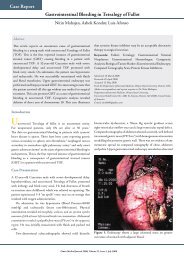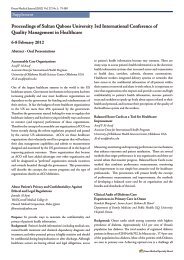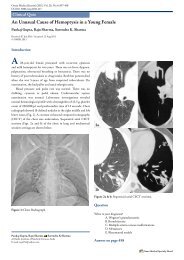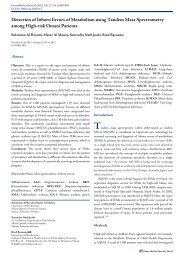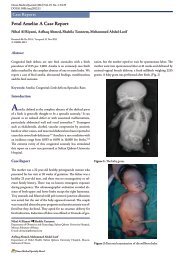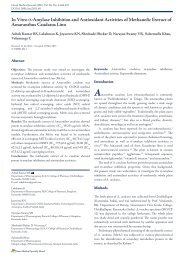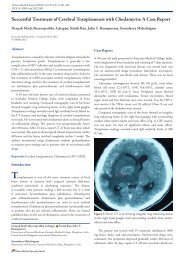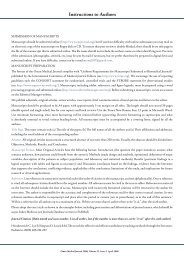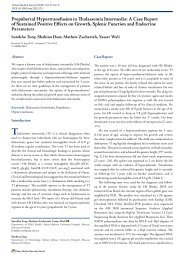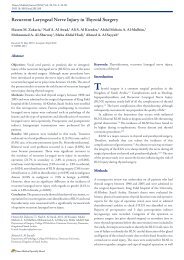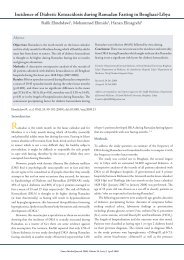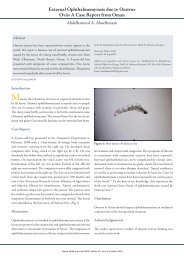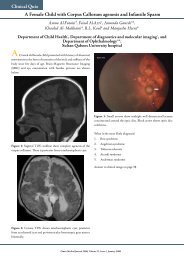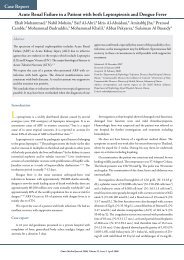Case of Neurosyphilis Presented as Recurrent Stroke - OMJ
Case of Neurosyphilis Presented as Recurrent Stroke - OMJ
Case of Neurosyphilis Presented as Recurrent Stroke - OMJ
Create successful ePaper yourself
Turn your PDF publications into a flip-book with our unique Google optimized e-Paper software.
<strong>C<strong>as</strong>e</strong> <strong>of</strong> <strong>Neurosyphilis</strong> <strong>Presented</strong> <strong>as</strong> <strong>Recurrent</strong> <strong>Stroke</strong><br />
Sudheer Ahamed, 1 Mammen Varghese, 2 El Noor El Agib, 2 V.S. Ganesa, 2 Marai Aysha 2<br />
Abstract<br />
A 46 year old male patient w<strong>as</strong> presented with a history <strong>of</strong><br />
hypertension, diabetes mellitus and coronary artery dise<strong>as</strong>e w<strong>as</strong><br />
reported to have had a cerebrov<strong>as</strong>cular accident <strong>of</strong> which features<br />
were suggestive <strong>of</strong> a new and rapidly progressive stroke. Upon<br />
investigation for recurrent stroke, the patient w<strong>as</strong> found to have<br />
a positive serology for Syphilis. The possibility <strong>of</strong> neurosyphilis<br />
w<strong>as</strong> considered, which w<strong>as</strong> later confirmed by positive serology<br />
in the cerebrospinal fluid. The c<strong>as</strong>e is lenghly discussed in this<br />
report to emph<strong>as</strong>ize the presence <strong>of</strong> syphilis in the 21st century,<br />
and to <strong>as</strong>certain its importance <strong>as</strong> an etiological agent in c<strong>as</strong>es <strong>of</strong><br />
recurrent stroke.<br />
Ahamed S, et al. <strong>OMJ</strong>. 24, 134-136 (2009); doi:10.5001/omj.2009.29<br />
Introduction<br />
The name Syphilis is derived from the Greek word “Syphilos”<br />
meaning crippled or maimed. Syphilis is usually a sexually<br />
transmitted infection characterized by episodes <strong>of</strong> active dise<strong>as</strong>e<br />
interrupted by latency periods. There are three characteristic<br />
stages <strong>of</strong> Syphilis namely; Primary, Secondary and Tertiary.<br />
The tertiary stage occurs in around one third <strong>of</strong> c<strong>as</strong>es and<br />
is manifested by progressive musculoskeletal lesions, aortic<br />
involvement or symptomatic central nervous system dise<strong>as</strong>e. The<br />
causative organism for Syphilis is a spirochete named; Treponema<br />
Pallidum which is a helically coiled organism me<strong>as</strong>uring some 5-20<br />
micrometers (µm) in length. Syphilitic infection <strong>of</strong> the nervous<br />
system results in one <strong>of</strong> the most chronic and insidious meningeal<br />
processes known. Central nervous system inv<strong>as</strong>ion occurs early in<br />
the course <strong>of</strong> untreated syphilis. 1 Therefore, patients not treated<br />
for persistent cerebrospinal fluid abnormalities are at risk <strong>of</strong><br />
developing clinically apparent dise<strong>as</strong>es.<br />
<strong>C<strong>as</strong>e</strong> Report<br />
A 46 year old Omani male patient w<strong>as</strong> presented in hospital with<br />
a history <strong>of</strong> weakness <strong>of</strong> lower left limb and tingling sensation in<br />
the upper left limbs for 3 days duration. The patient had a very<br />
significant medical history <strong>of</strong> hypertension, diabetes, Ischemic<br />
heart dise<strong>as</strong>e and stroke for 5 years causing a right sided hemiplegia<br />
which partially recovered. Clinical evaluation upon presentation<br />
revealed normal mental functions and no evidence <strong>of</strong> cranial nerve<br />
involvement. Motor examination showed bilateral weakness <strong>of</strong> both<br />
lower limbs with bilateral Babinski sign. There were no cerebellar<br />
signs and cardiac examination revealed a faint di<strong>as</strong>tolic murmur.<br />
Oman Medical Journal 2009, Volume 24, Issue 2, April 2009<br />
From the 1Department <strong>of</strong> Internal Medicine, Armidale Rural Refferal Hospital,<br />
Armidale, NSW 2350, Australia, 2Department <strong>of</strong> Medicine, Sohar Hospital, Sohar,<br />
Sultanate <strong>of</strong> Oman.<br />
Reviewed: 19 Dec 2008<br />
Accepted: 16 Feb 2009<br />
Address correspondence and reprint requests to: Dr. Sudheer Ahamed, Department<br />
<strong>of</strong> Internal Medicine, Armidale Rural Refferal Hospital, Armidale, NSW 2350,<br />
Australia.<br />
E-mail: sudheerahamed@hotmail.com<br />
However, there were no peripheral signs <strong>of</strong> aortic regurgitation.<br />
The patient developed a Broca’s type <strong>of</strong> aph<strong>as</strong>ia the next day and<br />
w<strong>as</strong> found to be choking on feeds. He w<strong>as</strong> found to have developed<br />
palatal weakness on his right side with bilaterally reduced gag<br />
reflexes. The patient w<strong>as</strong> also found to have a progression <strong>of</strong><br />
weakness on his left side suggesting a development <strong>of</strong> crossed<br />
hemiplegia with a progressing stroke indicative <strong>of</strong> a brain stem<br />
involvement.<br />
In view <strong>of</strong> recurrent progressive stroke and the relatively young<br />
age <strong>of</strong> the patient, it w<strong>as</strong> apparent that further investigations were<br />
required. A Computerized Tomographic (CT) scan <strong>of</strong> the brain<br />
arranged at the time <strong>of</strong> admission w<strong>as</strong> reported to be normal. A<br />
detailed stroke <strong>as</strong>sessment w<strong>as</strong> conducted and other tests including<br />
carotid and vertebral artery Doppler study, echocardiogram,<br />
connective tissue tests, thrombophilia screening, retroviral<br />
screening and Syphilis serology were performed. An MRI <strong>of</strong> the<br />
brain could not be performed due to logistical re<strong>as</strong>ons.<br />
The syphilis serology <strong>of</strong> the patient w<strong>as</strong> reported to be positive.<br />
This w<strong>as</strong> further confirmed with Treponema Pallidum Heam<br />
Agglutination test (TPHA) which w<strong>as</strong> also reported to be positive.<br />
The retroviral screening w<strong>as</strong> negative and the other tests did not<br />
detect any abnormality. Echocardiogram showed dilatation <strong>of</strong> the<br />
left ventricle with mild aortic regurgitation. A lumbar puncture<br />
w<strong>as</strong> performed and the fluid w<strong>as</strong> found to be clear with pleocytosis<br />
with a cell count <strong>of</strong> 56cells/ml and a high protein content <strong>of</strong> 101<br />
mg/dl. Cerebrospinal fluid Veneral Dise<strong>as</strong>e Research Laboratory<br />
(VDRL) test and TPHA were reported to be positive suggesting<br />
the possibility <strong>of</strong> neurosyphilis <strong>as</strong> a cause for the recurrent
stroke. The patient w<strong>as</strong> started on Crystalline Penicillin at a<br />
dose <strong>of</strong> 3 million units every four hours with careful observation<br />
for any evidence <strong>of</strong> Jarisch- Herx heimer reaction. Intravenous<br />
Penicillin w<strong>as</strong> administrated for the next 14 days. A repeat lumbar<br />
puncture w<strong>as</strong> planned but the patient refused. The patient w<strong>as</strong><br />
referred for rehabilitation and discharged on antiplatelets and<br />
antihypertensives regimen. A repeated cerebrospinal fluid analysis<br />
w<strong>as</strong> planned after 6 months.<br />
Discussion<br />
Tertiary syphilis h<strong>as</strong> become a rarity in the 21 st century. However,<br />
after a decade <strong>of</strong> decline, incidences <strong>of</strong> syphilis have incre<strong>as</strong>ed<br />
significantly. The pathology <strong>of</strong> tertiary syphilis involving the<br />
central nervous system in obiliterative small vessel endarteritis<br />
which usually involves the v<strong>as</strong>ov<strong>as</strong>orum. The clinical spectrum<br />
<strong>of</strong> tertiary syphilis includes the neuro syphilis, cardiov<strong>as</strong>cular<br />
syphilis and the late gummatous syphilis. 2 Quaternary syphilis,<br />
characterized by fulminant anergic necrotizing encephalitis is<br />
seen mostly in patients with coexistent retroviral infections.<br />
A patient with neurosyphilis may be totally <strong>as</strong>ymptomatic or<br />
present an acute syphilitic meningitis, meningov<strong>as</strong>cular syphilis,<br />
tabes dorsalis, optic atrophy or generalised paresis <strong>of</strong> insanity.<br />
Asymptomatic neurosyphilis is characterized by reactive serology<br />
in the cerebrospinal fluid along with other features such <strong>as</strong> elevated<br />
protein and pleocytosis. 3 Acute syphilitic meningitis usually<br />
presents features <strong>of</strong> meningeal irritation. Fever is rarely observed.<br />
Involvement <strong>of</strong> cranial nerves especially <strong>of</strong> 7 th , 8 th , 6 th and 2 nd in<br />
order <strong>of</strong> decre<strong>as</strong>ing frequency is common. Meningitis can be self<br />
limiting but can present more severe in later forms. The most<br />
common clinical syndrome <strong>of</strong> meningov<strong>as</strong>cular syphilis is stroke;<br />
in a relatively young adult it involves the middle cerebral or b<strong>as</strong>ilar<br />
arteries. Tabes dorsalis is a slowly progressive disorder involving the<br />
posterior columns and posterior roots <strong>of</strong> the spinal cord. Patients<br />
may experience with severe lancinating pains <strong>of</strong> the legs, ataxia and<br />
posterior column sensory impairment. Bladder incontinence and<br />
sexual dysfunction can occur. The rare delayed manifestation <strong>of</strong><br />
neurosyphilis is general paresis <strong>of</strong> insanity which usually occurs<br />
20 to 30 years after the initial exposure. It represents a chronic<br />
progressive frontotemporal meningoencephalitis with ongoing<br />
loss <strong>of</strong> cortical function. Ocular involvement in neurosyphilis can<br />
lead to posterior placoid chorioretinitis. 4 It is not clear whether the<br />
clinical spectrum <strong>of</strong> syphilis differs in an immunocompromised<br />
individual. However, recent data suggests that individuals who<br />
are immunocompromised have higher chances <strong>of</strong> developing<br />
neurosyphilis. 5<br />
<strong>C<strong>as</strong>e</strong> <strong>of</strong> <strong>Neurosyphilis</strong> Presenting... Ahamed et al.<br />
Oman Medical Journal 2009, Volume 24, Issue 2, April 2009<br />
The diagnosis <strong>of</strong> Syphilis is performed by serological and non<br />
serological tests. The serological tests can be further sub cl<strong>as</strong>sified<br />
into treponemal and nontreponemal tests. The non serological<br />
tests include; dark filed microscopy, direct immun<strong>of</strong>louroscence<br />
and demonstration <strong>of</strong> Treponema Pallidum in tissues. 6 Current<br />
recommendations for evaluation <strong>of</strong> neurosyphilis in any patient<br />
with positive serology for syphilis include those with focal<br />
neurological signs, patients with other late syphilis and c<strong>as</strong>es <strong>of</strong><br />
suspected treatment failure.<br />
In patients with concurrent Human Immunodeficiency Virus<br />
(HIV) infection and syphilis, the need for lumbar puncture to<br />
rule out <strong>as</strong>ymptomatic neurosyphilis is controversial. Centre for<br />
Dise<strong>as</strong>e Control (CDC) recommends a criterion <strong>of</strong> high pl<strong>as</strong>ma<br />
regain titre and CD4 cell count <strong>of</strong> equal to or less than 350cells<br />
/ml in these patients to consider lumbar puncture to rule out<br />
<strong>as</strong>ymptomatic neurosyphilis. 7<br />
Penicillin h<strong>as</strong> remained the drug <strong>of</strong> choice for all stages <strong>of</strong><br />
Syphilis. 8 A single dose <strong>of</strong> Benzathine penicillin in a dose <strong>of</strong> 2.4<br />
million units resulted in cure for more than 95% c<strong>as</strong>es <strong>of</strong> primary<br />
Syphilis. 9 Late latent syphilis and late syphilis without evidence<br />
<strong>of</strong> involvement <strong>of</strong> central nervous system h<strong>as</strong> to be treated with<br />
3 weekly doses <strong>of</strong> 2.4 million units <strong>of</strong> Benzathine penicillin.<br />
In contr<strong>as</strong>t, neurosyphilis requires treatment with crystalline<br />
penicillin with a dosage regimen <strong>of</strong> 2 to 6 million units every 4<br />
hours for a total <strong>of</strong> 10 to 14 days. An alternative is to use aqueous<br />
Penicillin G procaine at a daily dosage <strong>of</strong> 2.4 million units<br />
intramuscularly, along with 500 mg <strong>of</strong> oral Probenecid every 6<br />
hours for a course <strong>of</strong> 14 days. 10 Recommendations for treatment<br />
remain the same for HIV coinfected patients with syphilis. There<br />
is no data supporting the use <strong>of</strong> other antibiotics for the treatment<br />
<strong>of</strong> neurosyphilis, however the use <strong>of</strong> certain 3rd generation<br />
Cephalosporins and Azithromycin may merit further evaluation.<br />
In a recent study by Bai et al, published in the international journal<br />
<strong>of</strong> STD/AIDS, Azithromycin achieved a higher cure rate than<br />
Benzathine penicillin for early syphilis. 11<br />
The activity <strong>of</strong> neurosyphilis correlates best with cerebrospinal<br />
fluid abnormalities, notably the pleocytosis. The elevated protein<br />
levels slowly decre<strong>as</strong>e after treatment and the serological tests show<br />
a progressive decline in titre. A patient treated for neurosyphilis<br />
should have their cerebrospinal fluid reevaluated every 6 months<br />
for 3 years or until the findings return back to normal.<br />
Conclusion<br />
<strong>Neurosyphilis</strong> is thought to be rare in the 21 st century, however,<br />
the possibility should be considered in all c<strong>as</strong>es <strong>of</strong> recurrent
strokes, and particularly in c<strong>as</strong>es <strong>of</strong> stroke amongst young people.<br />
It is important to be aware <strong>of</strong> the therapy for neurosyphilis since it<br />
differs from the treatment <strong>of</strong> primary and late syphilis, due to the<br />
fact that adequate treatment can retard further progression <strong>of</strong> the<br />
neurological dise<strong>as</strong>e.<br />
References<br />
1. Marra CM. Update on neurosyphilis: Current Infect Dis Rep 2009; 11:127-<br />
134.<br />
2. Lukehart SA. Syphilis: Harrison’s principles <strong>of</strong> medicine. McGraw Hill New<br />
York. 16th edition. Chapter 153, p.977-979<br />
3. Burke JM, Schaberg DR. <strong>Neurosyphilis</strong> in antibiotic era- Neurology 1985;<br />
35:1368-1371.<br />
4. Chao JR, Khurana RN, Fawzi AA, Reddy HS, Rao NA. Syphilis:<br />
Reemergence <strong>of</strong> an old adversary: Ophthalmology 2006; 113:2074-2079.<br />
5. Zellan J, Augenbraun M. Syphilis in HIV infected patient: An update on<br />
epidemiology, diagnosis and management. Current HIV/AIDS Rep 2004;<br />
1:142-147.<br />
<strong>C<strong>as</strong>e</strong> <strong>of</strong> <strong>Neurosyphilis</strong> Presenting... Ahamed et al.<br />
Oman Medical Journal 2009, Volume 24, Issue 2, April 2009<br />
6. Young H. Syphilis: New diagnostic directions. Int journal <strong>of</strong> STD AIDS<br />
1992 Nov-Dec: 3.<br />
7. Ghanem KG, Moore RD, Rompalo AM, Erbelding EJ, Zenilman JM,<br />
Gebo KA. Lumbar puncture in HIV infected patients with syphilis and no<br />
neurological symptoms. Clin Infect Dis 2009; 48:816-821.<br />
8. Goldmeier D, Hay P. A review and update on adult Syphilis with particular<br />
reference to treatment. Int journal <strong>of</strong> STD AIDS 1993; 4:70-82.<br />
9. Gordon SM, Eaton ME, George R. The response <strong>of</strong> symptomatic neurosyphilis<br />
to high dose intravenous penicillin G in patients with HIV infection.<br />
NEJM 1994; 331.<br />
10. Jay CA. Treatment <strong>of</strong> <strong>Neurosyphilis</strong>. Curr Treat options Neurol 2006;<br />
8:185-192<br />
11. Bai ZG, Yang KH, Liu YL, Tian JH, Ma B, Mi DH, et al. Azithromycin vs<br />
Benzathine penicillin G for early syphilis. A meta analysis <strong>of</strong> randomized<br />
clinical trials. Int J STD AIDS 2008; 19:217-221.<br />
12. Website: CDC: Centre for dise<strong>as</strong>e control and prevention: Guidelines on<br />
sexually transmitted dise<strong>as</strong>es. http://www.cdc.gov/STD/. Access date June<br />
19, 2008.<br />
“2nd <strong>OMJ</strong> Scientific Writing & Peer Review”<br />
Workshop<br />
Date: March 6 - 12, 2010<br />
Time: 8:30 a.m. to 4:30 p.m.<br />
Venue: Al-Shafaq Club, Majan Hall, Armed Forces Hospital,<br />
Muscat, Sultanate <strong>of</strong> Oman<br />
Speakers: Mrs. Fiona Curlet<br />
Mrs. Eva Abdin<br />
Pr<strong>of</strong>. Ana Marusic<br />
For registration ple<strong>as</strong>e contact: 24499252 ext. 118<br />
or email us at omj@omsb.org



